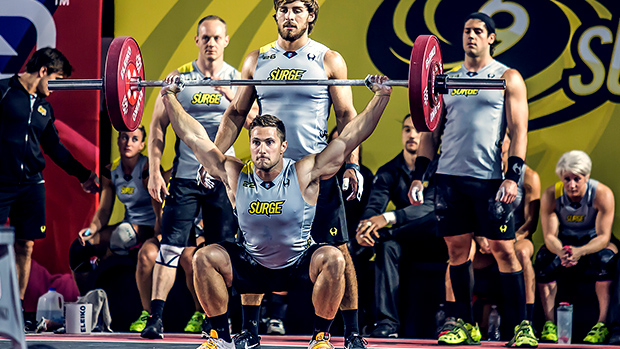Photos courtesy of Fat Tony (@FatTonyBMX) and the GRID League (@GridLeague)
Here's what you need to know...
- The National Pro Grid League (NPGL) is a team sport in which men and women compete together and against one another.
- The sport is also called the "GRID" which refers to the playing field, which is made up of two lanes and four quadrants. So, it's literally a grid.
- Each competition is called a match, and within each match there are eleven races. The races consist of gymnastic movements, O-lifts, and other fitness elements.
- Coaches select team members by specialty. Some are better at hoisting heavy barbells, others are better at bodyweight exercises and conditioning.
- There's a time cap on each race which means it's an extremely fast-paced sport to watch.
- Jim Kean, the CEO, says that one day NPGL may even become a college, high school, and military sport.
The Lifter's Team Sport?
Competitive fitness has gained traction in the last few years. New brands are forming, the most robust of which is the National Pro Grid League (NPGL).
"GRID" isn't an ever-changing gauntlet of exercises. Rather, it appears to be a wholly new team sport with set rules.
But does professional competitive fitness make sense? Can it win the fan base and participation that it needs to not just survive, but grow?
The National Pro Grid League
First off, it's not CrossFit, though it looks similar on the surface and there are some crossover athletes. And it's only fair to assume that the NPGL wouldn't exist without the CrossFit Games paving the way.
GRID is a team sport that's set up in a series of eleven different races, but the whole competition is called a match. Take a peek:
Each race requires the completion of various fitness elements containing Olympic lifts, squats, deadlifts, gymnastics, rope climbs, and more. Here are some of the specifics:
- There are currently eight NPGL teams: Baltimore Anthem, Miami Surge, Phoenix Rise, DC Brawlers, New York Rhinos, Los Angeles Reign, San Francisco Fire, and Boston Iron.
- "The GRID" refers to the playing field, which is an indoor area containing a central rig for body-weight and gymnastics elements, pull-ups, etc. with lanes on each side.
- Each team has a roster of 24, with an active roster of 18 athletes.
- Rosters must be half men and half women, with one 40+ athlete of each gender.
Specialized Skill > Widespread Skill
Team coaches select the best players to accomplish specific tasks. This is another major thing that differentiates the GRID from CrossFit.
A team might send out their smaller, highly-agile athlete to perform a rope climb, but they would send out their big bruiser to complete a slew of hang cleans.
Athletes with different body types and skillsets do their part, which looks completely different from what some of the other athletes are doing. GRID athletes must specialize, which is the opposite of what you see in CrossFit, which requires you to be proficient at just about everything.
For example, Dmitry Klokov, the Olympic silver medalist in weightlifting in 2008, is on the Baltimore Anthem team. His ideal role is strength and power tasks like squatting, deadlifting, and O-lifts.

But the coach wouldn't assign him to the race with kipping pull-ups, muscle-ups, or rope climbs. It'd be a poor use of his talents and energy and would hurt the team's chances of winning. (Plus he probably doesn't train those movements.)
Rather, they'd choose one of their gymnastics specialists for those events.
Injury-prevention is somewhat built into the sport by having athletes only do the things they specialize in. Putting the right player on the right task on the right race not only decreases injury potential, but also increases a team's chances at winning.
The same goes for tired players – if an athlete is dragging, the coach can sub him or her out for a fresh player who can do the job faster and more efficiently.
In CrossFit, the tired have to keep going to win, whereas in Pro GRID, the team will win if the tired athletes sit the bench while the fresh ones compete.
The Rules and How it Works
Even the most simplistic sports are marbled with confusing rules, and it takes a while to understand any new sport. There's a learning curve with GRID, but it's not as bad as most major sports.
You don't have to understand all the minutia. Here's the quick and dirty:
- Each match (all eleven races) takes roughly two hours.
- Teams earn points in each race: two for a win, one for finishing in second but before the time cap. Additional points can be earned in select races.
- Each race has a time limit, or cap. If a team finishes after it, they receive zero points.
- The team with the most points at the end of all eleven races wins the match.
- Some races are mixed gender, others are male or female only.
- Each team has their own lane that's broken into quadrants, and each quadrant has a different fitness element or task assigned to it.
- The teams move from the task in Quadrant 1, eventually to Quadrant 4, then to the finish line to complete a race.
- Five women and five men make up the starting lineup.
- Two men and two women start the match on the bench and can be substituted at any time between races. But, those who are subbed out can't return until the next match.
The New National Sport?
I contacted the league's CEO, Jim Kean, to find out more about GRID.
Dan Blewett: Does GRID need kids in order to survive and grow the sport?
Jim Kean: Would you bring an 11 year old to a pro football game?
Football games can be a rough, very unfriendly atmosphere for children. We instead hope to be more like minor league sports – providing an affordable, fun atmosphere for a family.
We think parents and children alike will appreciate that our sport features health, fitness, competition, and cooperation between men and women. Can you think of another pro sport that features men and women on the same team?
Dan Blewett: One way to attract fans is by signing big-name, exciting players. But big names demand big salaries. How does the GRID do it?
Jim Kean: Athletes in Pro GRID aren't going to get rich from their salaries, but many of them own gyms, are personal trainers, and see their off-season business revenue increase as a result of the TV exposure Pro GRID provides.
To fans we're not as much selling big names as we are selling a fun, wholesome night out for a family. And to the athletes, we're giving them a chance to grow their own brands, gain sponsorships, and promote themselves as incredible athletes and trainers.
Dan Blewett: Will the league be able to attract loyal fans? Can it survive without strong ticket sales?
Jim Kean: The league is funded in part by sponsorships and advertising, and ticket sales are one other part of our revenue stream.

Dan Blewett: What will the NPGL do when its athletes become injured? Does the NPGL have worker's compensation for athletes?
Jim Kean: Athletes are paid as employees of their respective team, so worker's comp is included within that; any injuries during competition would be handled that way.
As for the injury concerns, our sport is fundamentally different than CrossFit in a number of ways that combat poor technique due to fatigue.
Dan Blewett: How will GRID get upcoming athletes interested?
Jim Kean: One of our main projects is getting GRID into high schools and colleges. We also want to form military teams.
Dan Blewett: How will it compete with other sports like football, baseball, and basketball?
Jim Kean: Imagine you're a high school football coach, and GRID is offered as an offseason sport. We feel like those coaches would be excited to hear that their athletes spent the offseason playing GRID – pushing sleds, squatting, sprinting, deadlifting and competing – rather than sitting on the couch waiting for next season.
But, gymnasium space is at a premium, and most high schools wouldn't be able to install a somewhat permanent GRID into one of their gyms.
We'd most likely see one of our GRIDs installed at a local college which would allow local high schools to use it. Colleges would have more space and a higher budget and could make it more of a community project.
The Future of GRID
Whether or not the public takes to the sport is yet to be seen, but the leadership and work ethic behind the GRID seems strong.
Competitive fitness clearly isn't going away, so whether or not a professional league gains traction may simply be a matter of which league or brand rows hard enough to get the boat out past the breakers.
The rules and strategy of the sport make more sense when unfolding live. The NPGL is being televised on NBC, as well as streamed to the league website.
Even those who don't like traditional sports may enjoy the fast pace of the races. Time will tell.



